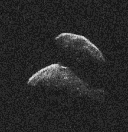File:PIA21597 - New Radar Images of Asteroid 2014 JO25.gif

Original file (1,280 × 720 pixels, file size: 5 MB, MIME type: image/gif, looped, 47 frames, 1.4 s)
Captions
Captions
Summary
[edit]| DescriptionPIA21597 - New Radar Images of Asteroid 2014 JO25.gif |
Afrikaans: Hierdie rolprent van asteroïde 2014 JO25 is saamgestel uit radardata wat op 19 April 2017 deur NASA se 230 voet-wye (70 meter) Deep Space Network-antenna te Goldstone, Kalifornië, verkry is. Toe waarnemings in 2014 begin het, was JO25 nog 1,53 miljoen myl (2,47 miljoen kilometer) van die Aarde af, en toe die waarnemings voltooi is, was die asteroïde reeds 1,61 miljoen myl (2,59 miljoen kilometer) weg.
Die asteroïde het 'n kontakbinêre struktuur, d.w.s. twee lobbe wat deur 'n nek verbind word. Die asteroïde se groter lob word op 2 000 voet (610 meter) in deursnee geskat. Asteroïde 2014 JO25 het die Aarde op 19 April tot binne 1,1 miljoen myl (1,8 miljoen kilometer) genader, 'n afstand wat oor die volgende 400 jaar nie geëwenaar sal word nie. Die resolusie van die radarbeelde is ongeveer 25 voet (7,5 meter) per pieksel, en 154 beelde is ingesluit. Meer inligting oor asteroïde 2014 JO25 kan op NASA se nuusblad en asteroidwatch gevind word.English: This movie of asteroid 2014 JO25 was generated using radar data collected by NASA's 230-foot-wide (70-meter) Deep Space Network antenna at Goldstone, California on April 19, 2017.
When the observations began 2014 JO25 was 1.53 million miles (2.47 million kilometers) from Earth. By the time the observations concluded, the asteroid was 1.61 million miles (2.59 million kilometers) away. The asteroid has a contact binary structure -- two lobes connected by a neck-like region. The largest of the asteroid's two lobes is estimated to be 2,000 feet (610 meters) across. Asteroid 2014 JO25 approached to within 1.1 million miles (1.8 million kilometers) of Earth on April 19. There are no future flybys by 2014 JO25 as close as this one for more than 400 years. The resolution of the radar images is about 25 feet (7.5 meters) per pixel. 154 images were used to create the movie shown. More information regarding asteroid 2014 JO25 can be found at https://cneos.jpl.nasa.gov/news/news196.html and http://www.jpl.nasa.gov/asteroidwatch. |
| Date | 19 April 2017 (published 9 May 2017) |
| Source | Catalog page · Full-res (GIF) |
| Author | NASA/JPL-Caltech/GSSR |
This image or video was catalogued by Jet Propulsion Laboratory of the United States National Aeronautics and Space Administration (NASA) under Photo ID: PIA21597. This tag does not indicate the copyright status of the attached work. A normal copyright tag is still required. See Commons:Licensing. Other languages:
العربية ∙ беларуская (тарашкевіца) ∙ български ∙ català ∙ čeština ∙ dansk ∙ Deutsch ∙ English ∙ español ∙ فارسی ∙ français ∙ galego ∙ magyar ∙ հայերեն ∙ Bahasa Indonesia ∙ italiano ∙ 日本語 ∙ македонски ∙ മലയാളം ∙ Nederlands ∙ polski ∙ português ∙ русский ∙ sicilianu ∙ slovenščina ∙ Türkçe ∙ українська ∙ 简体中文 ∙ 繁體中文 ∙ +/− |
 |
This media is a product of the Deep Space Network Credit and attribution belongs to the Goldstone Solar System Radar (GSSR) team, NASA/JPL-Caltech/GSSR |
| This file has an extracted image: PIA21597 - New Radar Images of Asteroid 2014 JO25 (cropped).gif. |
Licensing
[edit]| Public domainPublic domainfalsefalse |
| This file is in the public domain in the United States because it was solely created by NASA. NASA copyright policy states that "NASA material is not protected by copyright unless noted". (See Template:PD-USGov, NASA copyright policy page or JPL Image Use Policy.) |  | |
 |
Warnings:
|
File history
Click on a date/time to view the file as it appeared at that time.
| Date/Time | Thumbnail | Dimensions | User | Comment | |
|---|---|---|---|---|---|
| current | 00:50, 10 May 2017 |  | 1,280 × 720 (5 MB) | PhilipTerryGraham (talk | contribs) | User created page with UploadWizard |
You cannot overwrite this file.
File usage on Commons
The following 4 pages use this file:
File usage on other wikis
The following other wikis use this file:
Metadata
This file contains additional information such as Exif metadata which may have been added by the digital camera, scanner, or software program used to create or digitize it. If the file has been modified from its original state, some details such as the timestamp may not fully reflect those of the original file. The timestamp is only as accurate as the clock in the camera, and it may be completely wrong.
| Software used | Adobe Photoshop CS6 (Windows) |
|---|
